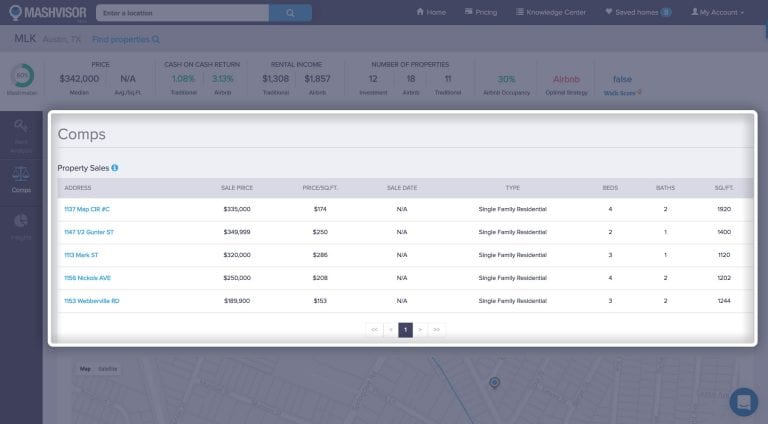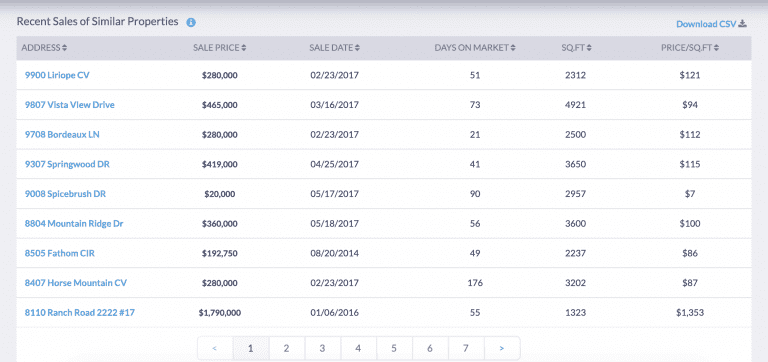Finding real estate comparables is an essential part of investing in real estate. No real estate investor can succeed in the business without using comparables, especially when it comes to buying and selling investment property. So, if you’re a beginner real estate investor wondering how to find comparables in real estate, then this is the guide for you.
What Are Real Estate Comparables?
First things first. Let’s start by defining this real estate term. Real estate comparables, or real estate comps for short, are recently sold properties that are similar or comparable to the one a real estate investor is analyzing. In order for a property to be considered as a comparable, it needs to be sharing the following characteristics with the property in question:
- Same location (within a radius of 3 miles)
- Same type (single family home, multi family home, apartment, condo, etc.)
- Same size (square footage, number of floors)
- Same room count (number of bedrooms and bathrooms)
- Same age (year of construction)
- Same condition (recently renovated or outdated)
- Same amenities (heating system, cooling system, etc.)
- Same features (balconies, verandas, garage, swimming pool, etc.)
Related: Question of the Day: Is Real Estate a Good Investment?
Why Do Investors Use Real Estate Comparables?
Real estate comparables are used by property investors in a Comparative Market Analysis (CMA) to:
1) Determine the Value of an Investment Property
Investors wanting to sell or buy an investment property use real estate comparables in order to determine the right price of the property they are dealing with.
On one hand, property sellers look at real estate comps to come up with their asking price. Examining the property value of similar houses in the local housing market helps them to avoid overpricing or underpricing their investment property for sale when listing it on the market.
On the other hand, property buyers look at real estate comps to come up with the best price to offer to the seller. Knowing how much similar houses in the neighborhood have sold in the past few weeks helps them to judge the fair market value of the property they want to buy. As a result, they can be sure that they’re not overpaying for the property, which, in turn, is key for making a profitable investment with high return.
2) Analyze the Performance of a Location
Before buying an investment property, investors need to run a real estate market analysis in order to evaluate the average performance of the location they’re interested in. As part of the real estate market analysis, they’re required to collect data about the market such as property prices, real estate appreciation, rental rates, and occupancy rates to see if it’s worth investing there. And to find such data, they need to look at real estate comparables in the area.
By looking at comparables, they can also understand how rental properties are performing in that market in terms of profitability. They can, therefore, predict whether buying rental property in that location is a good idea or not.
Related: How to Do a Real Estate Market Analysis in 2020
3) Set How Much to Charge for Rent
Real estate investors wanting to rent out one of their investment properties use real estate comps to come up with an appropriate rent to charge tenants. A real estate comparables analysis gives them an idea of how much other rental property owners are charging in the area. And as a result, they can use this data to set the right price for rent.
It is very important that investors set a rental price close to that of other similar properties nearby. In fact, if they charge higher for their rental property, they risk pushing potential tenants away. And if they charge lower, they risk losing money and ending up with negative cash flow.
Related: How Much Should I Charge for Rent?
How to Find Real Estate Comparables
Now that we’ve established what real estate comparables are and why real estate investors use them, we arrive at the most important part: How to find real estate comps?
The traditional way of finding comparables in real estate is to hire a real estate agent or appraiser. Agents and appraisers have access to the MLS, which is a database of properties that are currently for sale or that have been sold in a given location. They can easily pull real estate comps from data on the MLS and give you an accurate estimate of your home value in the current housing market. However, this way of finding real estate comps features one main drawback: it costs a lot of money, especially if you are the property seller.
The best way to find real estate comparables is to use a real estate comparables tool that allows you to access comparable properties on your own – without the help of any real estate professional. The tool we’re talking about is Mashvisor’s investment property calculator. It is one of the must-have real estate investment tools that every investor needs to be equipped with to succeed in the real estate investing business. It allows you to find real estate comps at two levels – the neighborhood level and the property level. Here’s how it works:
Neighborhood Level
As we all know, location plays a pivotal role in real estate investing. When it comes to buying an investment property, a real estate investor must not only find a good city to invest in, but also choose the best neighborhood in that city. Now, imagine having to find real estate comparables in several neighborhoods within a city to find out which one is the best out of all of them. That would require endless work! Fortunately, Mashvisor’s investment property calculator does all that work for you.
Using the tool, you can type in the name of any city in the US and get an overview of all the major neighborhoods in that city. You get to see important numbers such as the median property price, rental income, cash on cash return, and cap rate, as well as residential real estate comparables for each neighborhood.
Related: Mashvisor’s Investment Property Calculator: Real Estate Investing Made Easier
Property Level
Once you select a neighborhood, you get to see all the investment properties up for sale in that neighborhood. If you’re interested in a particular property, all you have to do is click on it, and this will give you an insight into the property. You will be able to see the expected rental income, return on investment (cash on cash return and cap rate), occupancy rate, expenses, and costs associated with that investment property – for both the traditional and Airbnb rental strategies.
Moreover, you will be able to see a list of recent sales of similar properties in the same area, along with the following information:
- Sale price
- Sale date
- Days on the market
- Property square footage
- Price per square foot
The image below shows an example of real estate comparables for an investment property for sale in the Austin real estate market:
You can download a CSV report containing all the real estate comparables that you’ve found for your target property and start your comparative market analysis immediately.
Sign up for Mashvisor to use our investment property calculator and get comparables for real estate from the comfort of your home!

